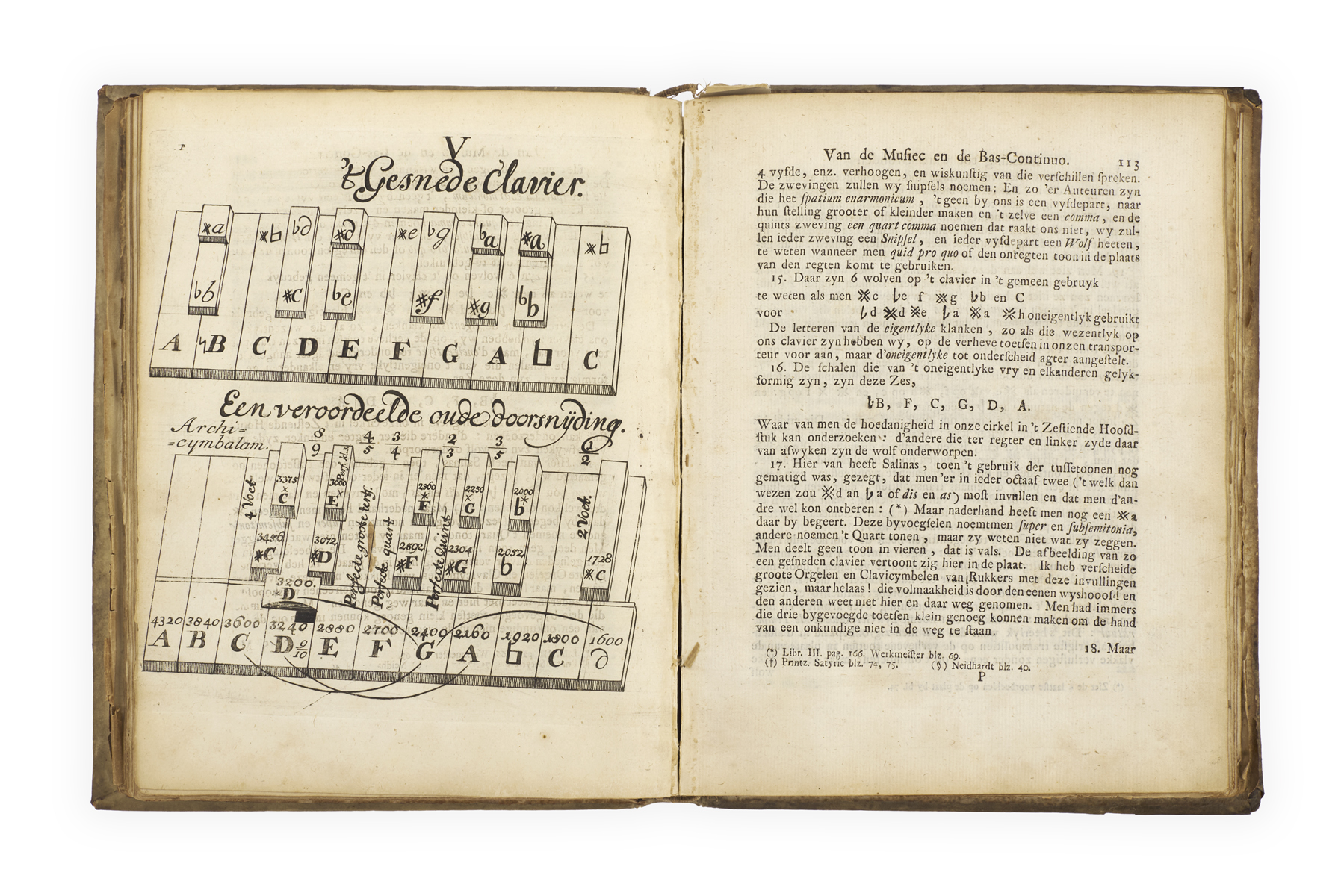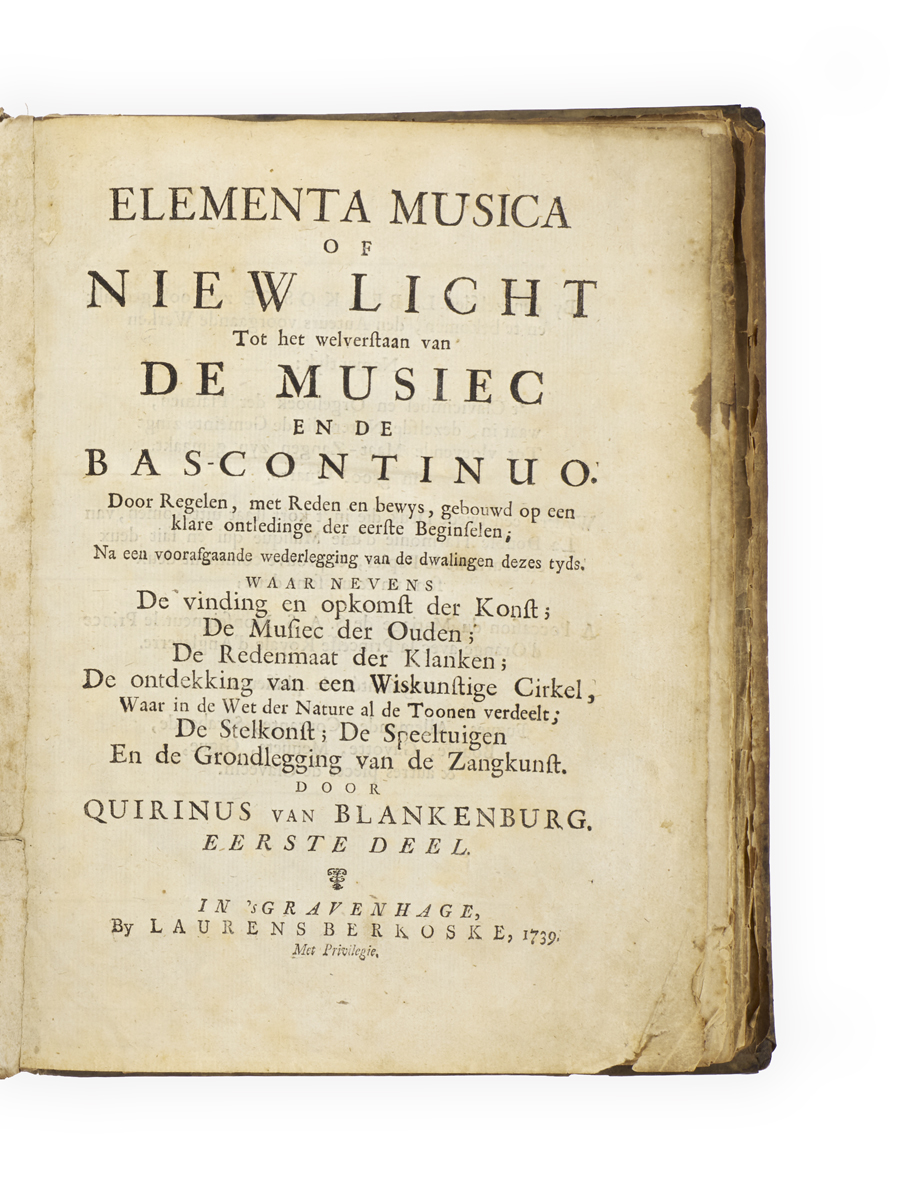

BLANKENBURG, Quirinus Gerbrandszoon van.
Elementa musica of niew licht tot het welverstaan van de musiec en de bas-continuo. Door regelen, met reden en bewys, gebouwd op een klare ontledinge der eerste beginselen; na een voorafgaande wederlegging van de dwalingen dezes tyds. Waar nevens de vinding en opkomst der konst; de musiec der ouden; de redenmaat der klanken; de ontdekking van een wiskunstige cirkel, waar in de wet der nature al de toonen verdeelt; de stelkonst; de speeltuigen en de grondlegging van de zangkunst.
The Hague, Laurens Berkoske, 1739.
Two parts in one volume, 4to, pp. [28], 200, [1, errata, laid in loose], with an engraved frontispiece-portrait (here bound before p. 1) and 26 [of 27] plates, of which four folding and two with volvelles, wanting the folding plate facing p. 94 with a sliding paper tab to aid transposition; three engravings in the text (including a complete fugue), woodcut head- and tail-pieces, woodcut initials; first few leaves thumbed, with loss to lower outer margins, some mild dampstaining to foot, a number of the plates laid in loose, proud of the fore-edge and consequently worn at edges; else a good copy in contemporary stiff panelled vellum, head of spine chipped.

Added to your basket:
Elementa musica of niew licht tot het welverstaan van de musiec en de bas-continuo. Door regelen, met reden en bewys, gebouwd op een klare ontledinge der eerste beginselen; na een voorafgaande wederlegging van de dwalingen dezes tyds. Waar nevens de vinding en opkomst der konst; de musiec der ouden; de redenmaat der klanken; de ontdekking van een wiskunstige cirkel, waar in de wet der nature al de toonen verdeelt; de stelkonst; de speeltuigen en de grondlegging van de zangkunst.
First edition, very scarce.
‘Quirinus van Blankenburg (1654–1739), son of an organist, followed in his father’s footsteps when he was sixteen, first in Rotterdam, Gorinchem, and then the Waalse Kerk in Den Haag; in 1699 he was appointed organist at the Nieuwe Kerk in Den Haag. Van Blankenburg matriculated at the University of Leiden and became a well-known teacher of music. His earliest work for harpsichord, a Preludium full of ornaments and sudden changes in tempo, is found in the London Babell MS (British Library Add. MS 39569) from 1702. None of his earlier works have survived, though it seems likely that he would have started to write music early in his life. From the works that we know now he comes across as an experienced composer.’
‘Van Blankenburg published three works toward the end of his life, though it is possible that he wrote them earlier … The majority of van Blankenburg’s keyboard works are short, the most elaborate being the Fuga obligata, published in his treatise Elementa musica, 1739, which covers basso continuo and other subjects, including details about enlarging the ambitus of harpsichords. Interestingly, a fugue with the same theme had been published by G. F. Handel in 1735, and, although the autograph of this fugue dates from around 1720, van Blankenburg accused Handel of plagiarism! He seems to be the first in the Netherlands to mention overlegato, which he calls “tenue”, and his fingerings are based on those found in François Couperin’s L’art de toucher le clavecin (1716)’ (Ton Koopman, ‘The Netherlands and Northern Germany’, in The Cambridge companion to the harpsichord, ed. Mark Kroll, 2019, pp. 71–92, pp. 77–8).
Provenance: from the collection of Gustav Leonhardt (1928–2012)
Hirsch I 73; RISM, Écrits p. 154.
